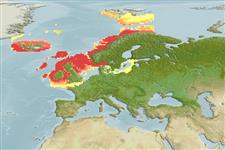>
Gadiformes (Cods) >
Gadidae (Cods and haddocks)
Etymology: Trisopterus: Greek, tris = thrice + Greek, pteron = wing, fin (Ref. 45335).
Environment: milieu / climate zone / depth range / distribution range
Οικολογία
Θαλασσινό(ά) βενθοπελαγικό; ωκεανόδρομο(ς) (Ref. 51243); εύρος βάθους 50 - 300 m (Ref. 54932), usually 100 - 200 m (Ref. 54932). Temperate; 79°N - 48°N, 27°W - 30°E (Ref. 54932)
Northeast Atlantic: southwest Barents Sea, sometimes at Bear Island, south to the English Channel, - and the Bay of Biscaye (Ref. 90172)-, around Iceland and Faeroe Islands.
Length at first maturity / Μέγεθος / Βάρος / Age
Maturity: Lm 14.0, range 11 - 15 cm
Max length : 35.0 cm TL αρσενικό/απροσδιόριστο; (Ref. 1371); common length : 19.0 cm TL αρσενικό/απροσδιόριστο; (Ref. 4645); μεγ. αναφερόμενη ηλικία: 5 έτη (Ref. 273)
Ραχιαίες άκανθες (συνολικά): 0; Εδρικές άκανθες 0. Gray-brown dorsally, silvery on sides, white on belly. A dark blotch is at the upper edge of the pectoral-fin base.
Benthopelagic to pelagic over muddy bottoms. Mostly found between 100 and 200 m. Feeds mostly on planktonic crustaceans (copepods, euphausiids, shrimps, amphipods) but also on small fish and various eggs and larvae (Ref. 1371). Caught mainly for reduction to fishmeal (Ref. 3383), trout pellets, fodder (Ref. 35388).
Oviparous, sexes are separate (Ref. 205). Migrates for spawning between the Shetland Islands and Norway and out of the Skagerrak. Major spawning grounds are Northwestern Scotland, Norway, Faeroe Islands and Iceland.
Cohen, D.M., T. Inada, T. Iwamoto and N. Scialabba, 1990. FAO species catalogue. Vol. 10. Gadiform fishes of the world (Order Gadiformes). An annotated and illustrated catalogue of cods, hakes, grenadiers and other gadiform fishes known to date. FAO Fish. Synop. 125(10). Rome: FAO. 442 p. (Ref. 1371)
IUCN Red List Status (Ref. 130435)
Threat to humans
Harmless
Human uses
αλιεία: πολύ εμπορικό
Περισσότερες πληροφορίες
ΑναφορέςΥδατοκαλλιέργειεςΠροφίλ υδατοκαλλιέργειαςΣτελέχοιΓενετικήElectrophoresesΚληρονομικότηταΑσθένειεςΜεταποίησηNutrientsMass conversion
Εργαλεία
Special reports
Download XML
Διαδικτυακές πηγές
Estimates based on models
Preferred temperature (Ref.
123201): 5.9 - 10.1, mean 7.8 °C (based on 185 cells).
Phylogenetic diversity index (Ref.
82804): PD
50 = 0.5625 [Uniqueness, from 0.5 = low to 2.0 = high].
Bayesian length-weight: a=0.00603 (0.00527 - 0.00689), b=3.06 (3.02 - 3.10), in cm total length, based on LWR estimates for this species (Ref.
93245).
Τροφικό Επίπεδο (Ref.
69278): 3.2 ±0.0 se; based on diet studies.
Ελαστικότητα (Ref.
120179): Μεσαίο(α), ελάχιστος χρόνος για διπλασιασμό πληθυσμού 1,4 - 4,4 έτη (K=0.36; tm=2.3; tmax=5; Fec=27,000).
Prior r = 0.50, 95% CL = 0.33 - 0.75, Based on 3 stock assessments.
Fishing Vulnerability (Ref.
59153): Low to moderate vulnerability (32 of 100).
Climate Vulnerability (Ref.
125649): Moderate vulnerability (41 of 100).
Nutrients (Ref.
124155): Calcium = 73.1 [20.9, 258.1] mg/100g; Iron = 0.802 [0.170, 3.524] mg/100g; Protein = 17.9 [15.4, 20.0] %; Omega3 = 0.627 [0.304, 1.293] g/100g; Selenium = 17.5 [8.3, 34.9] μg/100g; VitaminA = 25.5 [6.3, 108.2] μg/100g; Zinc = 1.25 [0.31, 3.42] mg/100g (wet weight);
